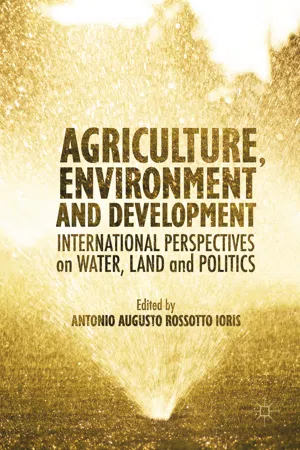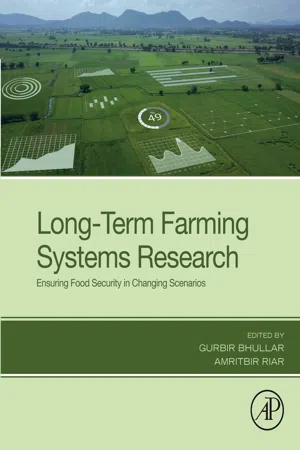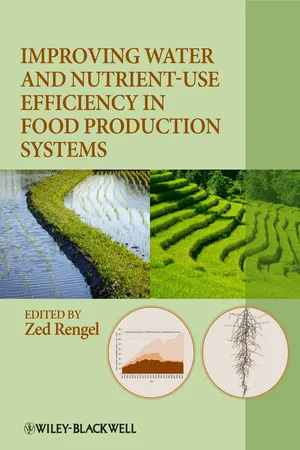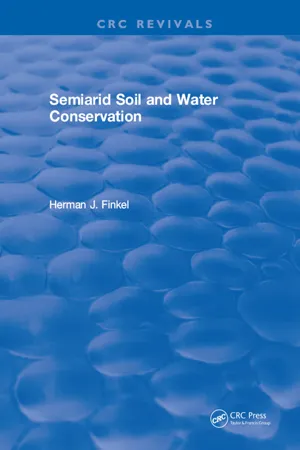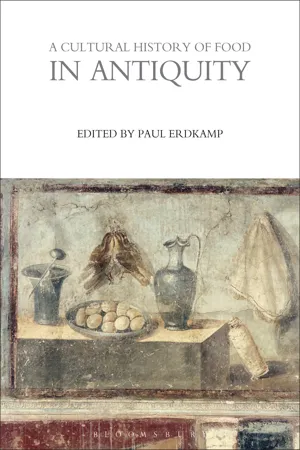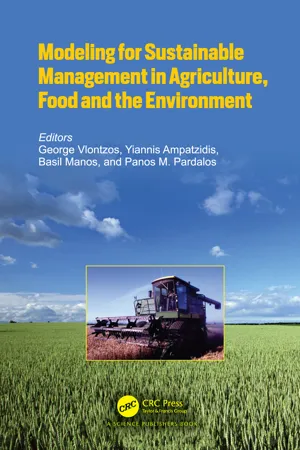Geography
Mediterranean Agriculture
Mediterranean agriculture refers to the farming practices and techniques used in the Mediterranean region, characterized by its mild climate, dry summers, and wet winters. This type of agriculture typically involves the cultivation of crops such as olives, grapes, and citrus fruits, as well as the rearing of livestock. Farmers in this region often employ terracing and irrigation methods to optimize their yields in the challenging Mediterranean climate.
Written by Perlego with AI-assistance
Related key terms
Related key terms
1 of 4
Related key terms
1 of 3
9 Key excerpts on "Mediterranean Agriculture"
- eBook - ePub
The Mediterranean
Environment and Society
- Russell King, Lindsay Proudfoot, Bernard Smith(Authors)
- 2014(Publication Date)
- Routledge(Publisher)
Figure 1.4 ). Wheat, vines and olives are the classic crop mix characteristic of Mediterranean Agriculture. However, the agriculture practised in each of the countries we shall be examining is also shaped by the existence of other climatic zones, and in this context there are important differences between the northern and southern shores. In southern Europe, Mediterranean Agriculture exists in countries (or unified markets) which also contain temperate zones – to the north of the Apennines we find the intensive arable farms of the Lombard plain. In the Maghreb the southern boundaries of the Mediterranean region merge into arid zones. South of the Atlas only low-intensity grazing is possible outside the oases, except in areas where irrigation systems operate. Throughout the Maghreb, the reliability of rainfall, even in winter, becomes a major factor in arable production and the region experiences periods of extensive drought. Consequently, agricultural production was based traditionally on a risk-minimising strategy incorporating dry-farming techniques, irrigation and stock rearing.The diversity of Mediterranean Agriculture is also derived from the marked variations in terrain, the origins of which were discussed in Chapters 2 and 4 . Throughout the region there are high mountain chains, many deforested and heavily degraded, where no forms of intensive agriculture are possible, and the limited economic activity revolves around grazing, or the odd belt of cultivated chestnuts. Lower down are the rolling hills and table-lands where rain-fed arable farming, olive groves and vineyards are common – this zone is more predominant in southern Europe than in North Africa. Finally, there are the lowlands and river valleys where more intensive agriculture based on irrigation has been practised for more than 2000 years, and where much of the capital-intensive farming is found today. These areas include citrus production in Andalusia, the ‘Golden Bowl’ around Palermo and the irrigated lowlands of the Maghreb; cotton production along the Guadalquivir; tobacco in the better-watered Greek Plains; and intensive fruit and vegetable production in favoured locations throughout the Mediterranean.There are also considerable variations in the agrarian social structures found in the region. In the immediate post-war period the countries of the Mediterranean littoral all had half or more of their active populations employed in agriculture, and the majority of these people were peasants, catering mainly for their own needs. We tend to think of peasants as a traditional and unchanging category of cultivators, but although much of the technology employed may have been ancient, many of the crucial economic and social characteristics of peasantries in the Mediterranean only emerged in the late eighteenth and nineteenth centuries, with the abolition of feudalism and earlier forms of property rights. Peasants used household labour to cultivate areas of land which rarely produced more than the foodstuffs required for home consumption and a small surplus for sale to obtain a few manufactured household goods. The land-holding of each family was small compared to Northern Europe, and often consisted of scattered plots rather than consolidated farms: this being both a consequence of the widespread practice of partible inheritance, and an ecological necessity for the practice of mixed agriculture in areas with very varied terrain. Davis (1973) gives a detailed case study of production patterns amongst small farmers in southern Italy. In the mountains and other marginal areas many households could not even produce basic subsistence needs from the land available, and relied on seasonal migrant labour to survive. Agriculture was unmechanised, and subject to a harsh and unpredictable climate: drought, flood, late frosts and desiccating winds. Even in the best of years, labour requirements were very variable, with long periods of inactivity interspersed with a few very busy months. As we shall see later on, since the 1950s the rural exodus and agricultural modernisation have removed the ‘peasant’ character of much Mediterranean Agriculture, but in marginal areas small-scale, semi-subsistence farming still survives in the hands of elderly farmers supported by pensions and welfare payments (see Fig. 13.1 - eBook - ePub
Agriculture, Environment and Development
International Perspectives on Water, Land and Politics
- Antonio A.R Ioris, Antonio A.R Ioris, Antonio A.R Ioris(Authors)
- 2016(Publication Date)
- Palgrave Macmillan(Publisher)
2011 ). Consequently, specific socionatural configurations and their evolution over time are key to understanding the agri-food system and acknowledging its territorial embeddedness and associated interdependencies in social, cultural, environmental, and economic terms in order to formulate interventions towards more sustainable and just futures.Curiously enough, despite the studies and data that challenge the widespread diversification and other related activities in Mediterranean Europe (Arnalte-Alegre and Ortiz-Miranda 2013 ), the Mediterranean stereotype has been championed in rural development paradigms as an example of post-productivism, multifunctional agriculture, and/or rural development success. This contradiction shows not only the importance of developing empirically grounded studies, but also the need to be critical about how not only discourses but also theoretical contributions are built. PE calls for a critical account of the production of knowledge , raising awareness of existing interests and how knowledge can also constitute a tool for exclusion and domination (Forsyth 2003 ). For example, most paradigms on rural development and agrarian change have been developed (and inspired) in an Anglo-Saxon context (and language), from productivist and modernization approaches to the eco-economy. My contention, therefore, is not only about the need for integration of other perspectives and socio-ecological systems, but also the need to raise awareness that the framings attached to these paradigms are conditioning our views on particular agri-food systems. This is clearly illustrated under the lens of modernization, where small family farms in the Mediterranean region were seen as backwards in the ‘development’ process. This notion of delay led to the design of agricultural and rural policies oriented towards reducing the structural gap with Northern European countries, that is, increasing the size of holdings to the detriment of other policy goals, namely environmental ones (Paniagua 2001 ). However, this also applies to the multifunctional approach that celebrates the production of high-quality foodstuffs despite creating markets only for middle- or high-income families. Of course, these framings have misguided not only academics but also policymakers in the context of the Common Agricultural Policy (Moragues-Faus et al. 2013 - eBook - ePub
Long-Term Farming Systems Research
Ensuring Food Security in Changing Scenarios
- Gurbir Bhullar, Amritbir Riar(Authors)
- 2020(Publication Date)
- Academic Press(Publisher)
However, scientific conclusions derived from long-term systems are not made with caveats, and some challenges inherent to long-term cropping systems studies, as well as the decision-making process that must occur over their long lifetimes, are discussed. Finally, the potential of long-term agricultural experiments to convene diverse groups of stakeholders, to inspire on-farm research, and to inform state and federal agricultural policy makes these experiments invaluable to science and society. Keywords Agroecosystems; Climate change; Irrigation; Mediterranean; Multifunctionality; Resilience One way of fostering this long view is through ‘listening places’—places set aside for patient and oft-repeated measurements, where our observations are melded into those of our predecessors, then handed off as heirlooms to those who follow us. In that way, we bequeath a lengthening legacy—a library expanding with time—from which to read the soil's memory and elicit portents of what is yet to be. H. Henry Janzen Introduction The highly productive and diverse agroecosystems of Mediterranean regions are considered the grocery baskets of the world, producing over 5% of the world's cereals, 7% of pulses, and 9% of vegetables, despite comprising less than 1% of global land area (FAOSTAT, 2019 ; Rubel and Kottek, 2010). Mediterranean regions are characterized by hot, dry summers and mild, wet winters during which the vast majority of precipitation falls. These conditions create environments with relatively low humidity and disease pressure in the summer, high growing degree days, and a highly controlled water supply, all of which form prime environmental conditions for crop production, especially for vegetables. Irrigation is almost always mandatory in Mediterranean agroecosystems for vegetable and fruit production - eBook - ePub
- Jala Makhzoumi, Gloria Pungetti(Authors)
- 2003(Publication Date)
- Taylor & Francis(Publisher)
Pungetti, 1996a ). Both town and house constitute key aspects of Mediterranean culture that have been taken into account in the development of this book, together with economy and related land use.The most important economic sector of the Mediterranean basin is agriculture. Itcurrently provides employment for nearly half of the labour force and it uses most of theland and water resources, leading to a competition between urbanisation andenvironmental conservation. Because population has grown faster than progress in food production, many Mediterranean countries are no longer able to feed themselves. In theprocess of trying to increase production, intensive cultivation by small farmers usingtraditional methods has produced soil degradation. Areas with potential for irrigation, inaddition, have used water inefficiently with rudimentary techniques, giving rise to aconsequent loss from run-off or evaporation. Agriculture has caused other problems, suchas pollution from fertilisers and pesticides, desertification due to the use of mechanicaltools, and erosion of upstream soil as a result of deforestation.Industry is the sector which has priority in terms of investment, research, technology,innovation, development programmes and regional policies. This was particularly true ofthe post-war period, when industrial development was fast and dominated by publicauthorities. However, an imbalance still exists between the north and southMediterranean: 70% of the basin’s manufacturing industry is concentrated in areas likeSpain, France and Italy (Grenon and Batisse, 1989 ).Fig. 2.3 The village of Old Gairo in Sardinia.The Mediterranean basin, it is known, is an important international tourist destination. Modern tourism, characterised by a massive influx during the summer to the seaside, originated on the French and Italian coasts but has now spread all over the basin. The impact of tourism is both physical, i.e. the need of space for tourist installations and required infrastructures, and socio-economic in that it changes life-styles and often leads to agricultural abandonment. In addition, there is its impact on the environment and the risk it poses in the over-exploitation of natural resources. Water consumption for instance is particularly high in the islands during the dry season, when forests are seriously threatened by fire. Plants and wild life furthermore can be damaged by the increasing number of tourists and their environmentally unfriendly attitudes. - Zed Rengel, Zed Rengel(Authors)
- 2013(Publication Date)
- Wiley-Blackwell(Publisher)
The Mediterranean region, especially the Middle East and North Africa, ran out of renewable freshwater decades ago. The region is one of the driest agricultural regions on Earth, containing only 1% of the world’s freshwater resources. The Mediterranean region is characterized by an extremely variable climate (Ceccarelli et al. 2007), with hot, dry summers and cool, wet winters, being the transition between dry tropical and temperate climates. This climate occurs on the west coasts of all continents between latitudes 30 and 45 degrees as a result of global air circulation patterns. Mediterranean climate is associated with an area of about 2.76 million km2 , corresponding to 2.3% of the Earth’s land surface. The largest part is the Mediterranean region with 1.68 million km 2 (60% of the total area of Mediterranean climate), followed by 0.61, 0.28, 0.13, and 0.06 million km 2 in Western Australia, California, Chile, and South Africa, respectively (Joffre & Rambal 2002).It is predicted that climate will change, with drier and hotter summer climate of the Mediterranean region including southern Europe and with hot dry spells all over Europe as a result of global warming (International Panel on Climate Change [IPCC] 2001, 2007). With respect to the winter season the situation is more complex. By the year 2050, rainfall during the winter (October–March) is predicted to increase in central and eastern Spain and northern Italy, whereas in the southern Mediterranean countries rainfall will decrease by 10% to 15% (Ragab & Prud’homme 2002). The average temperature in the Mediterranean region will increase by 1.25° to 2.5 °C in winter (Ragab & Prud’homme 2002). High temperatures may occur late in the winter growing season during seed filling. Salinization of costal aquifers will further exacerbate the situation (Wang et al. 2003).Irrigated agriculture is the biggest consumer of freshwater. Worldwide, more than 40% of food production is from irrigated land (Food and Agriculture Organization [FAO] 2006). In southern Europe, irrigation accounts for more than 60% of water use (Environmental Impacts of Irrigation in the European Union [EIIEU] 2000). The recurrent droughts and inefficient water use are threatening livelihoods, for instance in North Africa. This is why we have to focus on most efficiently using our water resources in agriculture. Thus, maximizing water productivity, and not yield per unit of land, is a strategy for farming systems in areas of water scarcity (Oweis & Hachum 2006).- eBook - ePub
Environmental Issues in the Mediterranean
Processes and Perspectives from the Past and Present
- John B. Thornes, John Wainwright(Authors)
- 2004(Publication Date)
- Routledge(Publisher)
in press).- Diversity is enormous. Spatial variations in geology, topography, soils and vegetation cover are so great that universal solutions do not generally apply. There is great cultural, political and demographic as well as biophysical diversity.
- Sustainability does not only mean conservation. It is a complicated concept involving the empowerment of local populations in environmental decision-making (O’Riordan and Voisey, 1998). The prophetic vision of Dovers and Handmer (1992), quoted in the Preface, is nowhere more apposite than in the contemporary situation of Mediterranean countries.
- Without local involvement, technical fixes are likely to prove unsuccessful. This is especially the case where land use changes are involved. The patterns of Mediterranean land use and land tenure involve complementarity. Chain-like reactions almost invariably follow changes.
- Hierarchical decision systems exist and this usually means hierarchically structured management plans. There must be discourse between, as well as within, levels of the hierarchy.
- The human dimensions of virtually all environmental issues are stronger and closer than in most other regions because of the evolution of a symbiosis between humans and nature in the Mediterranean. At the same time a preoccupation with the needs of end-users should not lead to a neglect of the fundamental physical controls in environmental problems. The interplay between people and nature is a deep and recurrent theme in this unique and complicated environment.
- Uncertainty and risk are major aspects of the Mediterranean environment, especially in relation to lack or excess of water. The Mediterranean is a hazardous place and environmental managers must engage in these issues. Unfortunately risk and uncertainty will always exist, whatever data-gathering and analysis exercises can be accomplished. The provision of a numerical estimate of the risk (e.g. in flooding) is not an adequate approach to the problem. Nevertheless, the preoccupation with indicators certainly stresses a greater faith in risk evaluation than is justified. The concentration should be on learning to live with risk and change and providing the capacity to deal with them, rather than continually attempting to estimate them. As Dovers and Handmer (1992) recognized: ‘Like natural systems, human systems need to be flexible enough to cope with uncertainty and unanticipated shocks
- eBook - ePub
- Finkel(Author)
- 2018(Publication Date)
- CRC Press(Publisher)
Chapter 5 PASTURE AND FOREST MANAGEMENT IN THE MEDITERRANEAN UPLANDS Ze’ev Naveh
I. INTRODUCTIONEditor’s note:Most of the chapters of this book are presented from the point of view of the engineer or the agronomist. This chapter uses the ecological approach based upon an analysis of the history and prehistory of the natural and human forces affecting the landscape, and development of a program for maximizing benefits from correct land use of pastures and woodland, consistent with the conservation and protection of the ecosystem. The Mediterranean uplands are described in considerable detail, as this is the region, above all others, where there is the longest available record of the effects of human intervention in the landscape-forming processes. It is not only typical of many semiarid regions, but may have special interest because it includes the land which is holy to many people around the world.There is probably no other region in the world that has endured more long lasting and intensive human impact throughout its history from the Pleistocene until present times than the Mediterranean Basin. There is also no other region where the unfortunate combination of a vulnerable environment and a long history of man’s misuse of the land have caused such far-reaching and severe damage of soil erosion and depletion, landscape desiccation, and what is called now “desertification”. Nowhere else are the dangers of combined traditional and neotechnological pressures from accelerating populations, tourists, and urban-industrial developments more threatening, causing new menaces of soil and water erosion, flooding, and land destruction. - eBook - ePub
- Paul Erdkamp, Paul Erdkamp(Authors)
- 2014(Publication Date)
- Bloomsbury Academic(Publisher)
The chapter examines three complementary bioarchaeological sources: human skeletal evidence of diet, archaeobotanical evidence for what plant foods were produced and how, and zooarchaeological evidence for the contribution of animals to diet and land use. In conclusion, it assesses the relationship between food production and social change and the importance in this regard of advances in technology or know-how and the diffusion of new crops or improved livestock. First, however, to inform the interpretation of the bioarchaeological evidence, it briefly considers traditional Mediterranean land use and the distribution of ancient population.TRADITIONAL LAND USEThe Mediterranean climate (hot dry summers, mild rainy winters) and accidented (i.e., rough, hilly) terrain have been credited with shaping three timeless features of premechanized land use: lowland cultivation of cereals alternating with fallow, growing in marginal hills of deep-rooted vines and olives, and the transhumance of large sheep flocks between lowlands in winter and mountains in summer. These practices were equally shaped, however, by the socioeconomic context. First, regular fallowing allowed large landowners using draught-oxen to grow cereals extensively —with minimal human labor—and so produce a large surplus, while neighboring smallholders practiced continuous cropping with draught cows or manual tillage. Second, the recent specialization in vines and olives, exploiting international demand for wine/currants and oil, was largely practiced by those with long-term rights to land and, especially for labor-intensive vines, with too little land for self-sufficiency in grain. Third, while arable farmers maintained smaller and less mobile herds, transhumant flocks declined sharply as the dissolution of lowland estates limited winter pasture on fallow land, as cheap imports of wool and cheese reduced the price of animal produce relative to purchased staple grains, and in southeast Europe, as new state boundaries hindered movement.Two polar models of recent land use have heuristic value for antiquity. Large landowners grew cereals for market extensively, and transhumant pastoralists similarly specialized in cheese and wool or textiles while symbiotically grazing and manuring the former’s fallow fields. Conversely, small-holders aimed for diversified self-sufficiency, growing a variety of crops (including labor-intensive pulses) and keeping a few mixed livestock for a range of products, though most sold some surplus grain or cash crops (wine, oil, cheese) to cover rents, fees, and luxuries. Those with insufficient land necessarily specialized in cash crops or crafts, however, or worked for larger landowners as sharecroppers, or especially at harvest, as day laborers. Poor specialists were vulnerable to fluctuating markets, but cereal-growing smallholders were also at risk, especially if paying tithes or taxes in cash rather than kind, as they sold grain cheaply after good harvests and bought it dearly after bad. Consequently, cereal-growing estates repeatedly re-formed in Greece after dissolution by Ottoman and Greek administrations; high prices after poor harvests enabled large landowners to extend their holdings and ensure a pool of poor, cheap labor. - George Vlontzos, Yiannis Ampatzidis, Basil Manos, Panos Pardalos, George Vlontzos, Yiannis Ampatzidis, Basil Manos, Panos M. Pardalos(Authors)
- 2021(Publication Date)
- CRC Press(Publisher)
2011, Malek et al. 2018). Severe droughts experienced in former times every 100 years will recur every 10 years in northern Mediterranean countries (García-Ruiz et al. 2011). Also, water scarcity in the Mediterranean is projected to increase under climate change prospects (Iglesias et al. 2011) and will become the predominant concern for Mediterranean farmers (Harmanny and Malek 2019). Changes in water resources are particularly relevant in areas where water availability is a limiting factor for economic development, such as Southeast Spain and the Ebro Depression, where the expansion of irrigated areas and urbanization have caused increasing water supply difficulties (García-Ruiz et al. 2011, Fader et al. 2016). Adaptation strategies in the Mediterranean basin include water management for irrigation, sustainable resource management (more nature-based strategies such as organic farming or the use of groundcover to control soil erosion), technological developments such as mechanization of farm production practices, cultivation practices (e.g. crop diversification and rotation), and farm management which include financial and administrative practices such as insurance and diversification of household income (Harmanny and Malek 2019). In Spain 21.3% of the whole land is covered by croplands (Eurostat 2017). Despite their decreasing intensity, internal agriculture conversions are still the second major driver of change in the Spanish landscape. The most frequent internal agriculture flow is the conversion from arable land to vineyards and orchards. Conversions from arable to permanent irrigated perimeters were very frequent between 2000 and 2006, but have almost disappeared from the landscape between 2006 and 2012. In this period, 59% of the artificial land was previously arable land and permanent crops (EEA 2017). Land abandonment processes started during the early decades of the 20th century and increased during the 1950s and 1960s (Lasanta et al. 2017)
Index pages curate the most relevant extracts from our library of academic textbooks. They’ve been created using an in-house natural language model (NLM), each adding context and meaning to key research topics.
Explore more topic indexes
Explore more topic indexes
1 of 6
Explore more topic indexes
1 of 4

